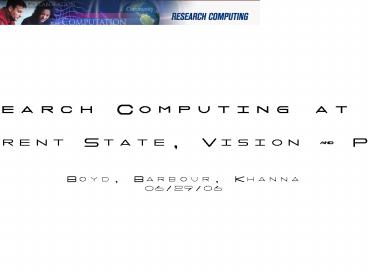PowerPoint Presentation research computing at rit - PowerPoint PPT Presentation
1 / 14
Title:
PowerPoint Presentation research computing at rit
Description:
Interviewed several dozens of faculty/researchers individually & continuing ... Molecular modeling for cataract research. George Thurston. EE. ... – PowerPoint PPT presentation
Number of Views:35
Avg rating:3.0/5.0
Title: PowerPoint Presentation research computing at rit
1
Research Computing at RIT Current State, Vision
Plan Boyd, Barbour, Khanna 06/29/06
2
Agenda
- Don Opening Remarks
- Diane ITS vs. Research Computing
- Gurcharan Research Computing
- Diane CIO Activities
- Don Follow up
3
Director of Research Computing Year 1
- Interviewed several dozens of faculty/researchers
individually continuing - Identified needs, set goals, developed plan
- Established a Directors Advisory Board (Don,
Diane, Guy, Stefi) - Building a connected RIT Research Community
(website list forums) - Partnered with faculty on external grant
proposals (Co-PI with CASCI, IT) - Assumed direct management of CIS permanent
computing staff - Managed LIAS staff to rebuild Condor cluster in
CIS - Resurrected IBM Cluster managing temp staff
building new clientele - Created Advanced Collaboration Technologies Lab
in CASCI - Obtained equipment donations from outside vendors
(Sun, Microsoft)
4
Current environment at RIT
- Ad hoc, home grown environments needing staff
support - Some faculty need more resources (CAST) while
others need support for what they already have
(COS) - Existing equipment not always stable -- in need
of upgrades and repairs (e.g. IBM Cluster in
CASCI, Condor System in CIS) - Faculty devoting time to systems administration
when they should be focused on research and grant
writing
5
Examples of unmet research needs
- Astronomy. Gravity models. David Merritt.
- Remote Sensing. Algorithm development, image
processing. Schott, Rhody. - CAST. New image compression algorithm
development. Chance Glenn. - Physics. Molecular modeling for cataract
research. George Thurston. - EE. Autonomous robotics, algorithm development.
Ferat Sahin. - CS. Combinatorial Math, Ramsey Numbers. Staczek
Radziszowski. - CE. Parallel Computing teaching and research. M.
Shaban, R. Melton.
6
Examples of shared computing systems at RIT
CASCI IBM 52 node cluster ROCKS .6 FTE
temporary Dual AC, heavy duty power Merritt,
Glenn, Melton, Thurston, Rafaelle
EE PSSC 24 node cluster linux PSSC ITS
machine room Sahin et al.
CASCI specialized GRAPE 32 node cluster linux
post-doc ambient air Merrit et al.
IT Mac server MacOS IT sys admin team server
room various IT, CS faculty
CIS Sun Condor 60 workstations cluster Solaris
ad-hoc sys admin open labs server room
Schott, Rhody, et al.
CS Sun Condor 200 workstations cluster Solaris
CS sys admin team open labs Radziowski, et al.
CE Dell 20 workstations cluster linux part of
CE sys admin overcrowded machine room Shaban,
Melton
CS Sun 32 node cluster etc. Solaris CS sys
admin team server room Kaminsky, Tyman, Haake,
et al.
7
Direct Benefits
- Save money through economies of scale via
- Centralized FTEs,
- Collocated systems,
- Efficient utility consumption
- Coordinated security
- Shared, effective use of facility spaces
- Increase researchers productivity
- More time on research, less time on technical
support - Higher levels of expert support and enhanced
research collaborations - Access to greater computational resources
- Advance science ask bigger questions, do better
science, increase scope of research
8
Indirect Benefits
- Enhance RITs prestige
- Provide a competitive advantage with peer
institutions - Increase public recognition
- Improve recruitment of faculty, staff and
students - Growth opportunities in staff and resources
9
Metrics of success
- Increased number of grant proposals
- Greater external funding
- More publications
- More citations
10
Plan of action
11
- 3 Tier Compute Systems Plan
12
Appendix
- What is a grid?
- A Grid is a network of autonomous nodes
connected together with standard protocols that
can be accessed by authorized users to
utilize pooled resources that are in aggregate
predictable, available, and greater than the sum
of its parts. - Ian Foster 7-20-2002
13
Appendix
- Types of Grids
- Power
- Compute
- Data
- Visualization
- Collaboration
14
Appendix Examples from other institutions
- Computers require support, and providing highly
skilled software support is costly. In some cases
the cost is figured in salaries for professional
systems administrators in other cases the cost
may be in time diverted from research. Our
subcommittee focussed on issues related to
computer software where we believe that steps can
be taken which can both save money and enhance
the effectiveness of research computing.
http//www.astro.princeton.edu/draine/SRCreport/n
ode1.html
- In the spring of 2004, ITS began an initiative to
support the research computing needs of the
faculty at Case.The mission of ITS Research
Computing is to facilitate cost-effective access
to IT resources for the research community at
Case. These resources include high performance
computing services, system administration
services, database hosting services, and
pre-award IT consultation. ITS Research Computing
is prepared to engage with faculty in
technologies as they emerge at Case, including,
for example, visualization and grid technologies,
and incorporate them into the suite of centrally
supported services.A major effort of ITS Research
Computing is the operation of the ITS pilot high
performance computing cluster. http//wiki.case.ed
u/Research_computing































